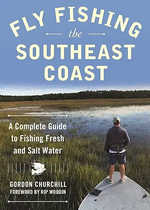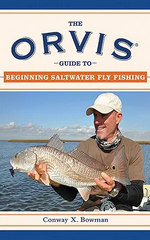Spey casting is an easy and fun way to cast a fly line that does not require a back cast. It can be done with traditional fly rods or with much longer two handed fly rods. There are several different form of the spey cast that can be used depending upon wind and current and user preference. Spey casting with a large two handed spey rod is generally employed on large rivers. I used my spey rod in the Delaware river when fishing for striped bass or small mouth bass and in the Salmon River when fishing for steelhead or salmon. In the smaller PA trout streams I routinely used a spey cast when there wasn’t room for an adequate back cast, which was very frequent.
I would encourage everyone to watch some videos of spey casting and to practice these techniques the next time they are on a stream. Although spey casting can be done on flat water, it really is much better employed with moving water. Certainly, any fly rod, especially one 8 ½ feet or longer in length with a weight forward line would work well. Although it could be used for dry flies the technique is much better suited for wet flies. After getting comfortable with spey casting with a regular rod, I would only consider purchasing a true spey rod with spey line and different weight tips if you plan to fish on really large rivers for very large fish, such as salmon, steelhead, or striped bass.
Spey casting is a fly-casting technique that evolved in Scotland in the mid 1800’s. It is named after the river Spey – one of Scotland’s premier salmon rivers – and is most likely where the technique started to be used. Spey casting has no true back cast. As a result it is particularly useful when fly fishing where there is little or no room behind the caster. When you look at the river Spey you will see why this technique needed to be developed and used. It is a wide, powerful river, that doesn’t allow anglers to wade out far enough to make back casting space. Traditionally Spey casting was for long, two-handed rods of 18 ft to 22 ft in length, and made of wood (called “greenheart”). They were used by anglers fishing for salmon in the rivers of Scotland and Norway. However, it is not only salmon anglers that have obstructions behind them, and Spey casting techniques are useful to all fly anglers.
True Spey casts are directional changes – something a roll cast cannot do effectively at all. They are also more dynamic and energetic casts than the roll cast, thus giving anglers the ability to make long casts with little room behind them. With a two handed rod, a good Spey caster can easily make a 120 ft cast with less than 10 ft of room behind them, and with a regular 9 ft #5 trout rod a good Spey caster can still make 70 ft casts with such limited room. No wonder this casting technique is getting so popular!
The two most commonly used styles of Spey casting are the “Single Spey” and the “Double Spey”. Mastering both the Single Spey cast and the Double Spey cast will be essential if the fly caster is to be able to cast from either bank of the river in whatever type of wind that may be present.
The Single Spey cast may be considered better by some, as it cast the line further, and it can be used with winds blowing upstream. This Single Spey cast is part of the “Splash and Go” (or touch & Go/Kiss & Go) group of casts.
These are the most common steps to achieve a Single Spey cast (when standing on the left bank of the river i.e. when looking downstream the bank you are standing on or nearest to is on your left)
1. Feed however much line you want to cast into the river, letting it drift downstream (to your left).
2. Make sure you’re facing downstream with the rod tip pointing down or the rod just off the water level.
3. Hold the lower grip of the rod with your hand that is on the downstream side (your left hand); the right hand is on the upper grip.
4. Lift the rod up at a steady pace so almost all of the line in the river is out of the water and being brought up towards you, and gently rotate your body to face more across the river & towards your target of the cast.
5. As you lift the line with the above move, this is followed by gently dropping the rod tip down in a small arc as you lift it upstream, and smoothly pull the rod up and upstream at the same time.
6. The end of the fly line, the nylon leader and the fly should come back upstream towards you, and you should aim for the fly and some of the leader to gently kiss the water about a rod length out in the river and a little upstream of your casting position; right before the fly kisses the water, raise the rod tip as if you were going to make a roll cast, and make a powerful forward stroke in the direction you are facing out across the river.
7. You should be able to achieve and angle change (the angle between where the fly line ended up downstream before the next cast, and where you want to cast to [target]) of around 45 degrees with ease.
8. As you make the forward casting stroke, the upper hand (right hand in this case) will push the rod and tip forwards towards the target, and the aerialised loop of line (from the rod tip to the water) will then be re-energized in the new direction of the casting stroke. The fly line will then progress over the river, unfurling the energized loop (the D Loop) as it goes, and the line, leader and the fly should end up towards the other side of the river (target).
The Double Spey cast may be considered easier to perform than the Single Spey, but only because this cast can be performed more slowly and deliberately, and corrections more easily made during elements of the cast. It is a sustained anchor cast in that some of the fly line stays in contact with the water at all times until the final forward casting stroke is made. This Double Spey cast is useful in downstream winds.
These are the most common steps to achieve a Double Spey cast (for a caster on river right – looking downstream, either the bank you are standing on or are nearest to is on your right):
1. Start with the line and fly downstream (to your right).
2. Rotate the rod steadily into an upstream position, keeping your rod tip horizontal & low to the river surface and your right arm extended.
3. The line, leader and fly will come upstream towards you, and the fly and leader should end up about a rod length away from your position, downstream and out into the river some. The tip of the rod is upstream of your position.
4. The rod tip is then swung out and around horizontally and quickly downstream, resulting in the line upstream of your position being gradually lifted or ripped from the water downstream, but not moving the ‘anchored’ position of the fly and leader; as you move the rod out and around downstream, the line follows the rod tip, and you will continue this rotation of the rod and lift the rod tip gradually as the rod tip passes your right shoulder, and the line will then follow to create the D loop downstream and behind your position;
5. Just as the creation of the D loop behind and downstream of your position is about the lift the anchored line tip, leader & fly, begin the forward casting stroke to launch the line, leader & fly in the direction opposite (180 degrees around) the D loop, and in the direction of your target across the river.
Article written by Cary Davidson



